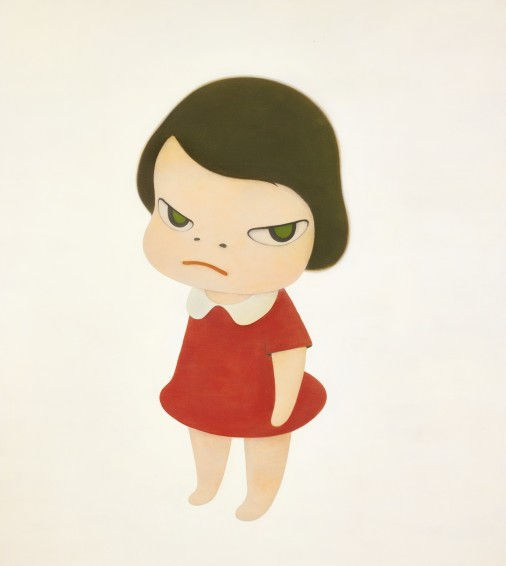Yoshitomo Nara’s Knife Behind Back: Discerning the Imperceptible
- Kyle Park

- Nov 21, 2021
- 3 min read
What could be frightening about a little girl standing innocuously in a childish red dress with a chubby-cheeked face, a short bob, and big eyes? Yet, take a closer look, and the little girl with a sneaky, Machiavellian expression hides something behind her back. The title of the painting, Knife Behind Back, reveals the reason for her determined look. The illustration of the young girl exerts an unsettling contrast between her age and her misdeed. Through this piece, Nara hopes to convey the importance of examining what lies behind mere appearances.
Yoshitomo Nara, a pioneering contemporary artist, was born in Hirosaki, Japan in 1959 and studied fine arts at Düsseldorf Public Academy and Aichi Prefectural University; he then started his career in the 1990s. When asked about his future aspirations, he explained, “I would liken my journey to a road movie that starts with the emergence of the ego of an art student through their work, then continues in the darkness of the night.” Indeed, Nara continues to walk into unknown realms of art, and the unparalleled Knife Behind Back is an artistic creation filled with enigmatic aura.
Nara’s Knife Behind Back exhibits an iconic and pervasive vision similar to that of Roy Lichtenstein’s blonde bombshells and Andy Warhol’s Marilyns. In his artworks, violence is omnipresent, though only hinted, and forms a striking contrast to the little girls and comical animals that are the main subjects of his paintings. In fact, these rebellious characters in Peter Pan collars are generally marked with malicious intent.
A pop icon, Nara amalgamates mainstream Eastern and Western culture, integrating features of both Japanese manga and American cartoons. “Many people try to find a link between my work and manga. Of course, this form of interpretation can lead to a satisfactory conclusion. But now there are all kinds of manga, all kinds of horizons.” Nara utilizes soft-hued colors with bold lines as seen in popular manga and finds beauty in simplicity. The equivocal nature of his simultaneously sweet and sinister characters ensures that there is an imperative ‘something’ underlying each of his works. Knife Behind Back is a classic archetype that employs Modernism’s shorthand language of images to create opportunities for personal resonance.
As Nara’s visual lexicon promotes a language undoubtedly redolent of manga, anime, and cartoon, viewers inevitably make appearance-based associations. Yet, the true meaning of Nara’s prolific oeuvre is revealed through the title and the absence of the referenced knife: the observer should focus on the imperceptible rather than visible elements. “I’m convinced that I am mainly influenced by invisible elements. Beneath the surface of the visible lie many things that remain imperceptible.” Intangibles such as emotions are an integral part of art that guides Nara during the creative process. “Everything I do involves freely using this body that performs automated actions to record every moment of the emotion in the painting.”
When we meet the eyes of Nara’s Knife Behind Back, emotions of anger, vexation, and loneliness are glaringly apparent––an indication that we must not shun but face these troubling sentiments. By emphasizing the wayward naïve aggression within the little girl, Nara once again reminds viewers vis-à-vis the invisible aspects of life. The Japanese artist offers a spiritual vision, declaring that first impressions are insignificant. “I feel like my means of expression does not aim to reveal an issue to society or to educate the public. I often wonder what people would think about if the world was ending tomorrow. If that day were to arrive. What I try to do is perhaps to create a painting that allows everyone, including me, to cope in such a circumstance.” Through virtuosic brushwork, Nara makes his piece a personal item to which each individual can relate. The ambiguity within his artwork further leaves them open for interpretation.
Confronted by a childish figure in a cutesy dress, Nara forces us to meet her penetrating gaze and open our eyes to fathom the painting’s hidden layers. Only then will we realize what lies beyond the visible.




Comments